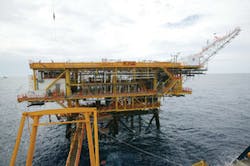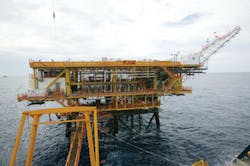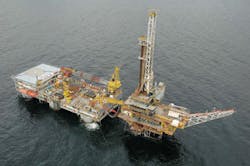Smart snake well achieves record flow for BSP off Brunei
Exploration and appraisal drilling picks up momentum
Jeremy Beckman, Editor, Europe
In January 2006, Brunei Shell Petroleum (BSP) delivered first oil from its Champion West Phase 3 development. Start-up was achieved several weeks ahead of expectation, but this was no routine field extension project.
Much of the challenge lay in design, placement, and control of the wells. BSP’s solution was derived in-house and involved combining a novel design, which snakes through the reservoir section, with extensive use of industry-standard downhole flow control valves, sensors, and gauges to optimize production. Without these, the development might not have been economic. Shell views the outcome as a standard-bearer for smart field technology.
Champion West is located 90 km offshore Seria in Brunei, and 7 km north-northwest of BSP’s main Champion field, which entered production in 1972. BSP is a joint venture between Shell and the Government of Brunei Darussalam.
Although Champion West was discovered in the 1970s, development was delayed until the early 1990s, due partly to concerns over reservoir productivity. The structure is 12 km long by 3 km wide, with depths fluctuating between 2,000-4,000 m. Reservoir pressures vary from 200-600 bar, with a temperature range of 80-120°C, and an average porosity of 16%. Sand quality is moderate (10-200 mD). Other challenges to overcome include highly stratified/laminated reservoirs with erratic fluid fill; narrow, elongated fault blocks; and thin oil rims (10-100 m) with a high degree of compartmentalization. There are over 1,000 reservoirs in Champion West.
Initially, BSP decided to exploit some of the field’s gas for lift purposes on the main Champion complex. Under a first phase of development, the company put in three wells to provide high-pressure gas, followed by three more in 1994. All these wells were re-completed as oil producers at the turn of the century under a new Early Oil Development project.
Four more oil wells were then added, after which BSP embarked on a second full phase development of Champion West. The associated drilling campaign, launched in 2003, comprised one appraisal well, one gas, and five oil producers.
Under the Early Oil program, BSP had addressed some of the more straightforward shallow oil reservoirs that featured thicker oil zones and no gas caps. These could be drained with highly deviated, semi-vertical fault scoopers (high-angled sections with a large inclination).
For the more complex Phase 2 targets, the project team opted to design horizontal snake-shaped wells to maximize drainage potential. Work on this brand-new concept started in 2001, with the first implementation in 2003 on a 1,500-m reservoir section of the Iron Duke field. BSP has since drilled 3-km reservoir sections in snake wells up to 6.7 km in total length; it is now aiming for 4- to 5-km reservoir sections in snake wells 8 km long that would intersect target sands up to five times.
According to Grahaeme Henderson, project leader for Champion West, the main difficulty with these types of wells is in the completion, using a pre-drilled liner. “To achieve completion, the dogleg severity needs to be controlled, and highly reliable directional tools are required.
“The end results, however, have been very positive. All our snake wells offshore Brunei to date have incurred low unit development costs, with very high initial flow rates. Drawdown is minimal, and the recovery efficiency from these wells is proving to be significantly better in many cases than that of vertical wells.
“The completions are ‘smart’, consisting of flow control valves, pressure gauges, and fiber-optic temperature sensors, and they are all operable remotely. These are augmented by our own in-house software for data analysis and online dynamic well control. By design, these wells do not require wellbore access for well or reservoir management, nor for maintenance.”
Optimized completion
Phase 3 of Champion West is actually split into three sub-phases - the current 3a, initiated in 2004, involves drilling five development wells from a newly installed platform using Smedvig’s tender assist rigWest Pelaut. The wells have shown excellent initial flow rates with the start-up producer - CW-29 - flowing at almost 17,000 b/d, or 2,650 cu m/d. This eclipses BSP’s record for a single well of 1,750 cu m/d achieved from Champion well CW-22.
Henderson attributes CW-29’s high reservoir deliverability to its snake trajectory and optimized completion design.
“This recent Champion West completion has two zones, each controlled by variable interval control valves (ICVs) to balance the offtake from either zone. Each zone has two pressure gauges associated with it on either side of its valve - one to measure reservoir pressure, and one to measure pressure inside the completion.
“The well is also equipped with a fiber-optic distributed temperature sensor to monitor its clean-up and in-flow behaviors, and to detect early signs of gas and/or water breakthrough in the future.”
The normally unmanned platform provides remote control access to BSP’s operations center in Seria via high bandwidth connections to the shore. This allows petroleum engineers to conduct:
• Real-time monitoring, clean-up, and optimization of the wells;
• Online well testing using a multiphase flow meter; and
•Rapid shut-down and start-up, as required.
“Many of BSP’s wells off Brunei have been optimized using smart field technologies,” Henderson says. “In one example, a plug of mud and clay was obstructing the toe, 700 m from the welbore, from contributing to flow. Once the ICVs were closed, and the well was produced from toe only, the plug was removed, and the reserves were reconnected to the well.”
The normally unmanned CWDP-1 Phase 3 platform was designed by Malaysia Marine and Heavy Engineering and Brunei-based Damit Worley Engineering. Construction of the jacket and deck was handled by local contractor, Adinin Works Engineering, at BSP’s yard in Kuala Belait. The 1,200-ton completed structure was installed last July by Teknik Lengkap Offshore. BSP itself was responsible for overall management of the project.
All produced fluids will be evacuated via two 16-in. multiphase pipelines (one for the oil wells, one for the gas wells) to the main offshore processing complex, Champion-7. In 2002, a new 28-in. pipeline was installed for export of associated gas from this complex to an onshore compression plant in Lumut, Brunei.
By the end of this year, all remaining Phase 3a wells should be online, at which point almost one-fifth of BSP’s total oil production will be coming from Champion West. Phase 3B will add five gas producers from late 2006 to early 2009, and three to four oil wells during 2008-09. Five more gas wells are planned for Phase 3C, from 2010 onwards, with the field by then supplying nearly 25% of BSP’s gas. Over time, the 10 gas wells should produce a total of 34 bcm, with initial planned flow rates of 2 MMcm/d from 5.5-in, tubing.
BSP estimates investment for all three stages of Phase 3 at $1.3-$1.5 billion.•



